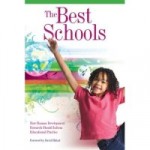 I’ve written a book for educators called The Best Schools: How Human Development Research Should Inform Educational Practice
I’ve written a book for educators called The Best Schools: How Human Development Research Should Inform Educational Practice (publisher: The Association for Supervision and Curriculum Development, December, 2006). In this book I suggest that our educational climate has become totally overwhelmed by what I call an “academic achievement discourse.” This discourse concentrates on accountability, rubrics, benchmarks, “closing the achievement gap’, a “rigorous curriculum,” “tougher standards,” and standardized testing. The epitome of this discourse is the No Child Left Behind Act, which demands that schools make yearly progress on test scores or face tough sanctions. What is missing from this conversation is any real discussion of human beings.
In my book I suggest that we need to start speaking (again, because we used to talk this way) “human development discourse.” That is, we need to focus on helping children develop their cognitive, social, emotional, creative, and spiritual potentials. We need to measure student progress, not through “normative” evaluation (comparing a child to an ideal group), but through “ipsative” measures (comparing a child to his or her own past performance).
We need to stop spending so much time focusing on basic reading and science and math skills, and provide more time in the curriculum for social studies, history, the arts, physical education, vocational education, wellness education, character education, and other fields that taken together make for educating whole human beings. In The Best Schools, I suggest that educators need to take seriously the unique needs of children at each stage of development, instead of creating developmentally inappropriate instruction to raise test scores at all age levels. I recommend that schools focus on specific developmental issues at each level of instruction.
- In early childhood education (ages 3-6) play should be the center of the curriculum, with no formal instruction (teaching reading and writing at this early age is developmentally inappropriate according to early childhood expert David Elkind, a leading advocate of Jean Piaget’s work in the United States).
- At the elementary school level (ages 7-10), learning how the world works should be the focus of classroom instruction. Children at this age are entering a more complex social world, they have more complex cognitive abilities, and they are hungry to know all about the world around them about nature, culture, other people and themselves. Too much time is being spent on preparing kids for tests, or teaching them silly irrelevant academic skills, and too little time is spent engaging students in rich encounters with the real world. The model of the children’s museum is a good one to use for this stage of schooling.
- At the middle school level (ages 11- 14), instruction should focus on social, emotional, and metacognitive growth. Adolescents entering puberty have a whole range of new emotions, social interactions, and intellectual insights descending on them, and to ignore these changes by focusing only on academic subjects like algebra and reading comprehension is to risk turning these kids off of school, and turning them toward gangs, violence, drugs, addictions, and other social problems. Middle schools should teach using peer instruction, cooperative learning, and mentor-guided experiences. They should teach school subjects by engaging the students’ emotions (e.g. teaching the Revolutionary War by asking students if they ever felt like revolting against anything). Students should also have their newly-developed “meta-cognitive minds” engaged (where they can think about thinking itself) both in academic learning, and also in thinking about the conflicts in their often emotional turbulent personal lives.
- Finally, high schools (ages 15-18) need to focus on helping students prepare to live independently in the real world. In middle and late adolescence, students are beginning to take on responsibilities that will make them a part of the adult world (between 15-18 kids in many states are able to marry, open IRA accounts, drive, and engage in other adult responsibilities). Instead of having to spend all their time cooped up in a large impersonal high school, where they have to raise their hand if they want to go to the bathroom, they should be out in the real world engaged in internships, field work, cooperative education, job shadowing, career academies, part-time jobs that link with academic instruction, and other educational models that help these kids across the great divide separating childhood from adulthood.
All of these developmental goals require that schools that have become testing factories radically alter their direction, their purpose, and their structure. The Best Schools provides many examples of schools at all levels around the United States that are already doing this; that are already providing developmentally appropriate instruction for kids and treating kids not as test-taking machines, but as whole human beings.
To read excerpts of The Best Schools, click here.
To read a review of The Best Schools in the online Teachers College Record, click here.
To order The Best Schools, click here
This article was brought to you by Thomas Armstrong, Ph.D. and www.institute4learning.com.
Follow me on Twitter: @Dr_Armstrong


















